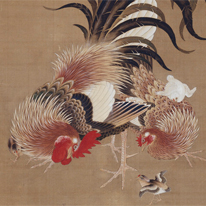Past Exhibitions
- New Trends in Edo Painting: Nanpin and Western Styles
- June 9, 2015 - July 5, 2015
It is widely known today that while Japan was closed off to the outside world as a matter of policy during the Edo Period (1603-1868), that did not mean it rejected all outside cultural influences. There were in fact trade ports at Nagasaki and elsewhere, albeit under the control and supervision of the Tokugawa Shogunate, and through these a large number of cultural products entered Japan, enriching the flourishing culture of the era. Notably, a Qing dynasty Chinese painter named Shen Quan came to Japan in the early 18th century and had a major impact. The Nanpin style of painting he brought with him spread quickly to Kyoto and environs and then to Edo, taking Japan by storm. Meanwhile, the copperplate engravings, etchings and oil paintings imported into the country through trade with the Netherlands and other Western nations, unlike the earlier first flush of interest in Western-style painting, were incorporated into Japanese techniques and influenced a wide range of artists.












